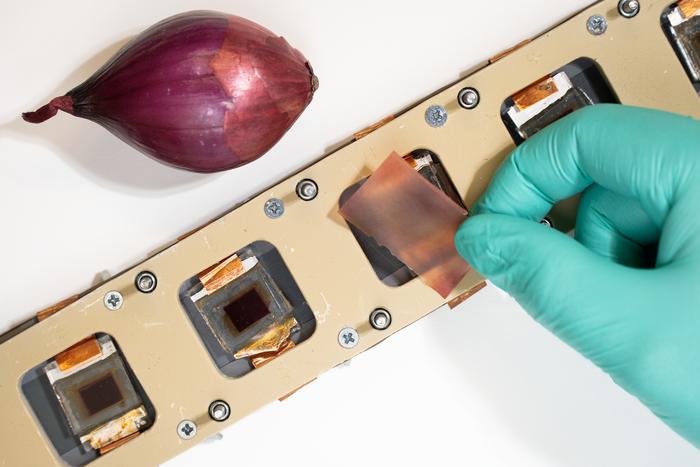Recent advancements in renewable energy technologies have sparked an interest in the development of protective materials for solar cells. Researchers at the University of Turku in Finland, in collaboration with Aalto University and Wageningen University, have made significant strides in this area, focusing on the use of bio-based materials to produce effective ultraviolet (UV) protection films. This innovative study is deemed groundbreaking as it marks the first investigation into the long-term properties of different bio-based UV filters when applied to solar cells.
Solar cells, while efficient in converting sunlight into electricity, are susceptible to damage from UV radiation, a common source of degradation. Traditionally, protective films made from petroleum-based plastics, such as polyvinyl fluoride (PVF) and polyethylene terephthalate (PET), have been employed to shield solar cells from these harmful effects. However, the ongoing quest for sustainable alternatives has highlighted the potential of bio-based materials, such as nanocellulose, in this domain.
Nanocellulose is derived from cellulose, which is broken down into nanoscale fibers. This material can be engineered to possess various properties, including UV protection. The collaborative research efforts have revealed that nanocellulose treated with natural dyes, particularly from red onion skin extract, offers exceptional UV protection capabilities. Tests conducted by the teams indicated that this novel UV filter effectively blocks 99.9% of UV radiation below 400 nanometers, outperforming the conventional PET-based UV filter used as a standard in the study.
Doctoral Researcher Rustem Nizamov from the University of Turku emphasized the promising potential of using nanocellulose films dyed with red onion extract in applications demanding bio-based material solutions. The research unveiled that the four different types of protective films tested, made from cellulose nanofibers and treated with diverse materials (red onion extract, lignin, and iron ions), showcased varying degrees of UV protection, with the red onion-treated film emerging as the superior option.
Balancing UV protection with visible light transmission presents a substantial challenge when developing bio-based materials. While UV radiation is detrimental to solar cells, the transmission of visible and near-infrared light is crucial, as this light is needed for electricity generation. Lignin, despite its effective UV absorption properties, is unsuitable for transparent films due to its dark pigmentation. The film treated with red onion dye, in contrast, achieved remarkable stability in visible light transmission, exceeding 80% light transmission at wavelengths ranging from 650 to 1,100 nanometers over extended periods.
Extensive testing of the durability and effectiveness of these bio-based UV filters involved simulating 1,000 hours of artificial sunlight exposure, equivalent to roughly one year of outdoor conditions in Central Europe. Researchers carefully monitored visual changes in both the filter materials and the accompanying solar cells using advanced digital photography techniques. The long-term testing underscored the critical nature of evaluating UV filters over time, as the performance and light transmittance of several tested materials diminished significantly.
For example, while iron ion-treated films initially presented strong transmittance, their effectiveness deteriorated with aging, illustrating the importance of longevity in UV filtration performance. The dye-sensitized solar cells, known for their vulnerability to UV radiation, were specifically targeted in these tests, yet the findings carry implications across various solar technologies, including perovskite and organic photovoltaics.
Nizamov expressed hope for future advances in the field, stating a vision for the creation of biodegradable solar cells that could serve as power sources for innovative applications, such as sensors in food packaging. As the forest industry pursues high-value products, the integration of new technologies with sustainable practices is of great interest.
The Solar Energy Materials and Systems (SEMS) research group at the University of Turku is dedicated to advancing the application of solar energy systems in our energy infrastructure. Collaborative research promoting bio-based alternatives is funded through the BioEST project by the Research Council of Finland, highlighting the importance of interdisciplinary efforts in addressing global challenges surrounding energy sustainability and environmental protection.
The scientific community eagerly anticipates the publication of these findings in esteemed journals, as the implications of such bio-based UV filters not only broaden the potential use cases for solar technology but also encourage the shift toward greener materials in various industrial sectors. The continued exploration and understanding of nanocellulose and its derivatives in renewable energy applications reflect a step forward in the quest for sustainable energy solutions.
As innovations continue to unfold in the quest for effective and sustainable materials to protect solar cells, these findings pave the way for a future where solar energy can power our world while minimizing environmental impact. The importance of such advancements cannot be overstated, as they signify an emerging convergence of scientific research and environmental consciousness committed to achieving sustainable energy for all.
In conclusion, the collaboration between researchers in Finland and the Netherlands highlights the significant role of bio-based materials in the future of solar energy technology. The examination of bio-based UV filters serves as a crucial reminder of the potential for natural materials to play a vital role in the sustainability of renewable energy applications and highlights the need for further research in this promising area.
Subject of Research: Bio-based materials for UV protection films for solar cells
Article Title: Sustainable Nanocellulose UV Filters for Photovoltaic Applications: Comparison of Red Onion (Allium cepa) Extract, Iron Ions, and Colloidal Lignin
News Publication Date: 24-Feb-2025
Web References: ACS Applied Optical Materials
References: None provided
Image Credits: Väinö Anttalainen
Keywords
solar cells, UV protection, nanocellulose, bio-based materials, sustainable energy, red onion extract, renewable energy, photovoltaic applications, lignin, material engineering.
Tags: bio-based materials for solar energycellulose-derived materialscollaboration in renewable energy researchinnovative materials in solar technologylong-term properties of UV filtersnanocellulose applicationsnatural dyes in nanotechnologyprotective films for solar cellsred onion dyeRenewable Energy Technologiessustainable alternatives to plasticsUV protection for solar cells





